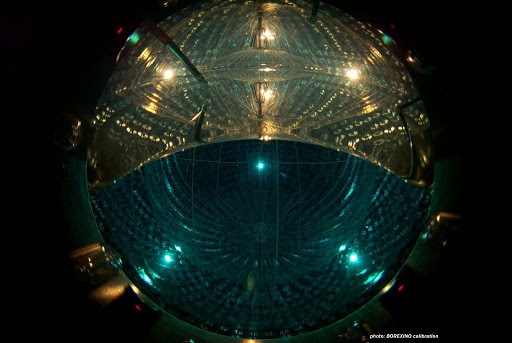
Borexino, an experiment at the Gran Sasso National Laboratories, published in Nature last year the first ever detection of neutrinos produced in the Sun by the CNO cycle (carbon-nitrogen-oxygen). It is an experimental result of historical value, which completes a chapter of physics that started in the 1930 decade of the last century. The implication of this new measure for understanding stellar mechanisms is enormous: in fact, since the CNO cycle is predominant in the most massive stars than the Sun, with this observation Borexino has reached the experimental evidence of what is in fact the dominant channel in the universe for hydrogen burning.
Previously Borexino had already studied in detail the main mechanism of energy production in the Sun, the proton-proton chain, through the individual detection of all neutrino fluxes that originate from it. Now, by measuring the neutrinos produced by the CNO cycle, which is present in the Sun at 1% level, Borexino provides the first experimental evidence of the existence of this additional energy generation mechanism.
Further information can be found on this article by D. Franco and D. Vignaud: https://theconversation.com/lenergie-qui-emane-du-soleil-est-100-nucleaire-la-preuve-par-les-neutrinos-154017
As a result of these measurements, Borexino was awarded the Giuseppe and Vanna Cocconi prize by the European Physical Society for its outstanding contribution to Particle Astrophysics and Cosmology or the groundbreaking observation of solar neutrinos from the pp chain and CNO cycle that provided unique and comprehensive tests of the Sun as a nuclear fusion engine. Such observation is also providing invaluable information to address the long-lasting solar metallicity problem (the density of elements other than hydrogen and helium), and for neutrino physics through the measurement of the electron neutrino survival probability.
The APC team has participated in the Borexino experiment since its conception with an important involvement in the data analysis started in 2007.
The 2021 Giuseppe and Vanna Cocconi Prize for an outstanding contribution to
Particle Astrophysics and Cosmology is awarded to the Borexino collaboration for the
groundbreaking observation of solar neutrinos from the pp chain and CNO cycle that
provided unique and comprehensive tests of the Sun as a nuclear fusion engine.
Solar neutrinos were first detected by the Homestake experiment in the US, and have
contributed to the discovery of neutrino oscillations by the SNO experiment in Canada
and Super-Kamiokande in Japan. The Homestake experiment was sensitive to
neutrinos emitted above a threshold of 0.814 MeV, and the SNO and Super-
Kamiokande experiments measured the high tail, above 4.0 MeV, of the neutrino
energy spectrum. The Borexino experiment situated at the Laboratori Nazionali del
Gran Sasso is the only experiment capable of measuring the full spectrum, above 0.19
MeV, of solar neutrinos in real time. To achieve the required performance the
experiment had to reduce radioactive contamination by about ten orders of magnitude.
Solar models suggest that 99% of the nuclear energy released by the Sun originates
from the fusion of two protons (the pp-chain), which can propagate via three reaction
sequences. The only direct proof of these reactions are the neutrinos produced.
Borexino reported the first complete measurement of neutrino fluxes from the three
sequences in 2018 through the analysis of more than 2000 days of data [1]. Borexino
provided an estimate of the total power generated by nuclear reactions in the Sun’s
core with a 10% uncertainty, in full agreement with the estimate from the measured
solar luminosity, and a spectacular demonstration that nuclear fusion is the engine
generating the energy of the Sun.
The remaining 1% of the Sun’s energy production takes place through the CNO cycle,
where 4He synthesis is catalyzed by reactions on Carbon, Nitrogen and Oxygen. While
the CNO cycle provides an almost negligible contribution to the Sun’s energy, stellar
models predict that it is the dominant reaction for stars heavier than about 1.3 solar
masses, about 10% of the stars in our galaxy. A direct proof of the CNO cycle was
missing. CNO neutrinos are hidden behind pp-chain neutrinos and have a spectrum
similar to that produced by the decays of Bismuth-210, which contaminates the
Borexino scintillator. It required five years’ effort to understand and constrain the
Bismuth-210 contamination, resulting in the first experimental evidence in 2020 of
neutrinos produced through the CNO fusion cycle in the Sun [2].
The observation of pp-chain and CNO neutrinos are also providing invaluable
information to address the long-lasting solar metallicity problem (the density of
elements other than hydrogen and helium), and for neutrino physics through the
measurement of the electron neutrino survival probability.
Borexino was approved in 1996 and began data taking in 2007. It’s a collaboration by
25 international institutes, running at Laboratori Nazionali del Gran Sasso, Italy. For
more information see the Borexino Web Site.
[1] Borexino Collaboration, “Comprehensive measurement of pp-chain solar
neutrinos”, Nature 562 (2018) 7728, 505-510
[2] Borexino Collaboration, Experimental evidence of neutrinos produced in the CNO
fusion cycle in the Sun, Nature 587 (2020) 577-582
Services/Groupes:
- Particules
Objet de la publication:
Distinctions, prix
